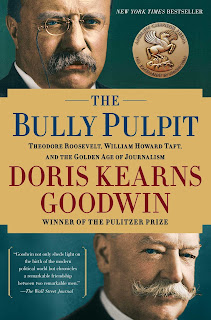The Bully Pulpit: A Jolly Good Book!
Doris Kearns Goodwin writes big books. I have an intimidating pair of them. Her 2005 book about Lincoln, Team of Rivals, stretches 917 pages, 121 of those pages are notes. The Bully Pulpit: Theodore Roosevelt, William Howard Taft, and the Golden Age of Journalism, a "brief" 892 pages, has but 96 pages of notes. I worked my way through The Bully Pulpit first. Intending to sound like one of the work's principal subjects, Theodore Roosevelt, it was "a jolly good read!"
In The Bully Pulpit, Kearns Goodwin paints vivid, attractive portrayals of Theodore Roosevelt and William Howard Taft through their lives as young men, colleagues and friends, president and cabinet-member, fierce adversaries, and reconciled old friends. Alongside these principal characters, we meet their wives, their families, and the journalists who covered them.
We meet Archibald Butt, who loved and served both presidents as a military aide and confidant. Kearns Goodwin tells of his death in a manner that thoroughly surprised me, even though I studied the historical event which captivated me as a child.
We encounter Jacob Riis, whose life deserves greater recognition. (I recommend heartily this book.) Kearns Goodwin makes S.S. McClure come alive in full dimension. We encounter Ida Tarbell, Ray Baker, Lincoln Stephens, Upton Sinclair, and Kansas' William Allen White.
The Bully Pulpit, while intimidating in size, is elegantly written. Perhaps the book incarnates the Roosevelt adage: "Speak softly, but carry a big stick." The stories, well-told, are magnificent. Take your time; this book is worth it.
In The Bully Pulpit, Kearns Goodwin paints vivid, attractive portrayals of Theodore Roosevelt and William Howard Taft through their lives as young men, colleagues and friends, president and cabinet-member, fierce adversaries, and reconciled old friends. Alongside these principal characters, we meet their wives, their families, and the journalists who covered them.
We meet Archibald Butt, who loved and served both presidents as a military aide and confidant. Kearns Goodwin tells of his death in a manner that thoroughly surprised me, even though I studied the historical event which captivated me as a child.
We encounter Jacob Riis, whose life deserves greater recognition. (I recommend heartily this book.) Kearns Goodwin makes S.S. McClure come alive in full dimension. We encounter Ida Tarbell, Ray Baker, Lincoln Stephens, Upton Sinclair, and Kansas' William Allen White.
 |
| Doris Kearns Goodwin (Credit: LBJ Foundation) |




Comments
Post a Comment